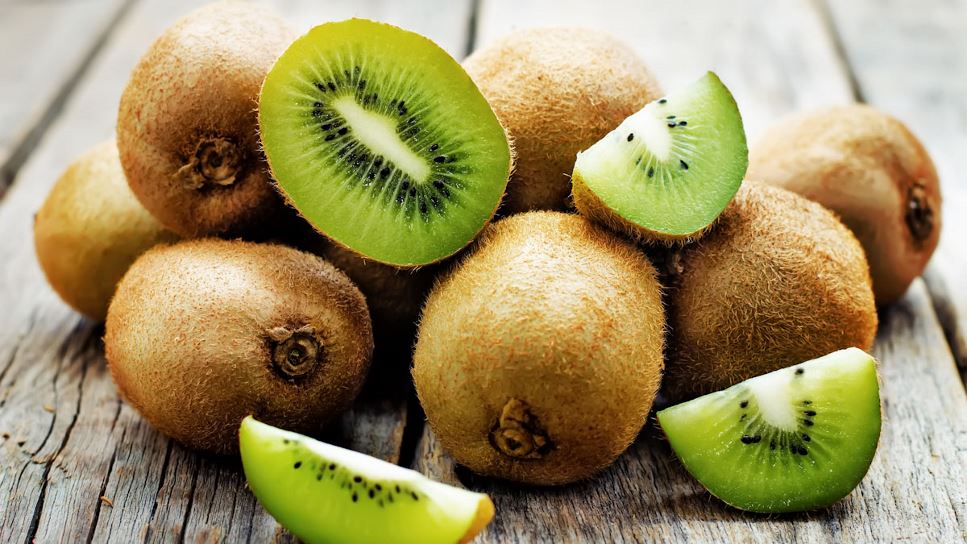Although an icon of New Zealand, kiwifruit originated in China and was known as the Chinese gooseberry. Its name was changed to kiwifruit for market appeal when New Zealand began to export the fruit. They say to never judge a book by its cover, and in the case of kiwifruit, that’s certainly true. You’d never guess from its fuzzy brown exterior that there’s a bright, beautiful color and pretty pattern of black seeds inside — and a treasure load of nutrition, too.
Nutritionally Speaking
One medium kiwifruit, depending on variety, provides about 40 to 50 calories, 70% to over 100% of daily vitamin C needs and more potassium than half a banana.
Kiwifruit also offers dietary fiber and phytochemicals, including phenolics and carotenoids. A growing body of evidence supports its beneficial effects in gut health, including constipation. Research suggests that regularly eating kiwifruit may have a beneficial effect on biomarkers related to diabetes, cardiovascular disease and stroke.
Actinidin, the most abundant protein in kiwifruit, is also its major allergen. Kiwifruit should be avoided by people with a latex allergy or at risk for latex sensitivity.
Growing
The main varieties of kiwifruit are the popular, fuzzy on the outside, bright green on the inside Hayward variety with a sweet-tart taste; the patented gold variety with smooth, edible skin and a sweeter, more tropical taste; and baby kiwifruit (also known as kiwiberries) about the size of a grape, with a bright green interior and smooth skin.
Kiwifruit grows on a vine and may take three or four years to begin producing once planted. Kiwifruits are handpicked and snapped off the base of the kiwi’s stem. Kiwifruits sweeten after picking.
Availability
Kiwifruit is available year-round, with producers in New Zealand and Chile tag-teaming spring production, while California growers harvest in the fall.
Purchasing
Kiwifruit can be found in nearly all grocery stores. Baby kiwifruit may be more difficult to hunt down, but you may find them in mainstream grocers as well. When selecting kiwifruit, those with the sweetest flavor will yield to gentle pressure and are ready to eat. Avoid those that are very soft or shriveled. Kiwifruit that’s too firm isn’t yet ripe.
Storing
Ripe kiwifruit yield to gentle pressure; firmer ones ripen in a few days if left at room temperature, and they become mushy when they’re past their prime. Kiwifruit can be stored in the refrigerator for up to two weeks. Once ripe, store kiwifruit apart from other ethylene-producing fruit, like peaches and bananas, to prevent over-ripening.
Preparing
Most people eat kiwifruit raw, peeled and sliced, or cut in half and scooped out with a spoon, but its skin — fuzzy or smooth — is an edible source of fiber. Kiwifruit’s bright flesh ranges from emerald green to golden yellow, with tiny, edible black seeds and a unique sweet-tart flavor that some describe as a cross between a strawberry, pineapple, melon and banana.
Using
Kiwifruit contain a unique enzyme called actinidin, which is an excellent meat tenderizer. Rub a sliced kiwifruit half over meat or mash kiwifruit and spread it on top. Actinidin breaks down proteins in dairy products and prevents gelatin from setting; in recipes, add kiwifruit just before serving. Heating actinidin inactivates it, so you can cook kiwifruit for a few minutes before adding it as an ingredient.
Kiwifruit add not only a gorgeous hue, but a delightful sweet-tart flavor to dishes and drinks. It is a colorful ingredient in fruit salads, chicken salad and Mediterranean couscous. Shake up creative concoctions by adding pureed kiwifruit to drinks. Kiwifruit’s natural acidity adds zip to salsas, chutneys and jams. Mashed kiwifruit blended with honey and lime juice makes a tasty salad dressing. Kiwifruit’s flavor complements meats such as teriyaki steak, pork roast and ham. A staple on fruit tarts, kiwifruit is also delicious as a chunky topping for shortcake, frozen as sorbet or in dessert sauces. Kiwifruits are prominently featured on a favorite Down Under version of pavlova: meringue topped with whipped cream and sliced strawberries, passion fruit and kiwifruit.
This information originally appeared in Food & Nutrition Magazine®, published by the Academy of Nutrition and Dietetics.
References
Find a Nutrition Expert
Looking for credible nutrition information and recommendations? The Academy of Nutrition and Dietetics' network of credentialed food and nutrition practitioners are ready to help!

